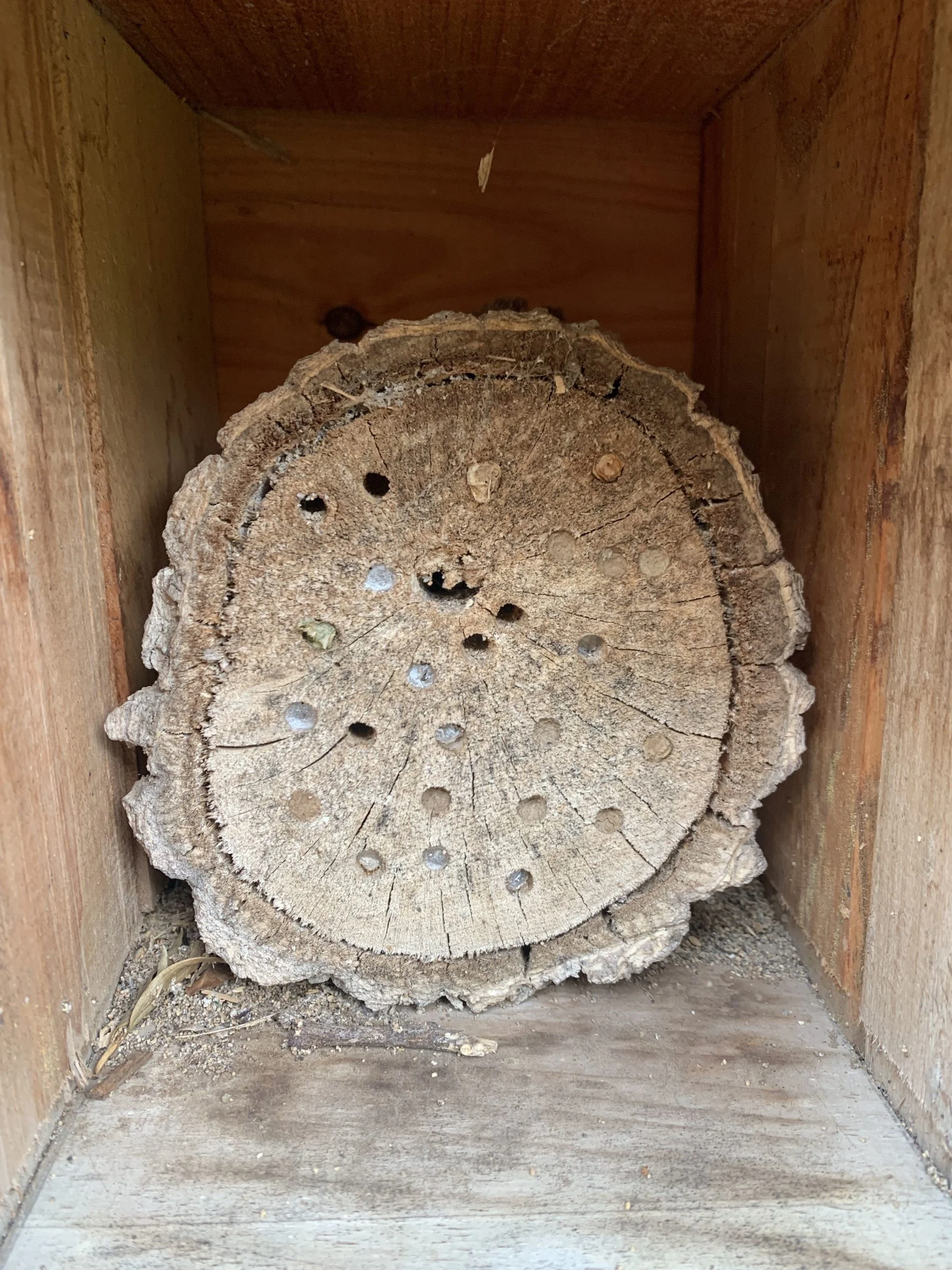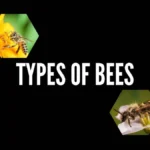What is the ideal mason bee hole size? When we build nests for mason and other solitary bees we are typically catering for a broad range of solitary pollinators who will inhabit a nesting site we create. Let us have a look at how to get this to work best for us.
What Is A Mason Bee Nest?
Mason bees are solitary bees that nest typically in holes and then close the hole up with mud, hence the name ‘mason” or builder. There are many different species of mason bees, and each bee has a different size. An example is the Red Mason bee. There are many other solitary bees, some of which are leafcutter and carpenter bees.
Sometimes people will refer to a Mason Bee Nest – this is misleading. The bees are solitary, and what you really have is a Mason Bee nesting site. This is a place where many bees gather to make their nests. Hence it is actually a whole lot of nests, not just one. If you compare this to a beehive, you have a queen bee and her workers in a beehive or bee nest. So let us just remember – you don’t get a Mason bee nest – you get a Mason bee nesting site.
The Solitary Bee Nesting Site I Built
In 2012 I decided to build a solitary bee nesting site for my Mother as a birthday gift. She is an avid gardener, and unlike me, does not want honeybee hives in her garden. I don’t mind getting stung – she does. Solitary bees are very effective pollinators for beans, tomatoes, and various other typical garden vegetables. The nest I built for her was designed to be attractive to a broad range of solitary pollinator bees such as mason bees, leafcutter bees, and carpenter bees.

When I built this I provided a lot of different options for different types of solitary bees to build their nests. We will have a close look at the various nesting sites shortly. Over the past nearly decade, this nesting site has attracted many different types of mason bees, carpenter bees, leafcutter bees, and other mysterious unknown creatures that look like bees or pollen wasps.
Mason Bee Hole Diameter
When you build a solitary bee nesting site, the thing to bear in mind is you are working with wild insects. These insects would normally scout an old rotten branch or similar spot and find borer beetle holes and modify these as their nesting sites.
Each solitary bee has an optimum hole size for its nesting purposes. This is an excellent article that shows how the actual hole size affects the development of a mason bee. Giving the bee the best hole size to select, gives it the ability to produce the healthiest offspring.
Herein however lies the problem. There are thousands of species of solitary bee, and for most of us, a few handfuls of species we can entice into our nests at home. My method was to drill a lot of holes of various sizes.

Here we can see that the holes that were 8mm (about 0,3″) in diameter have been completely occupied. Rather interestingly, I drilled some much smaller holes and these have all been excavated and “corrected” to the 8mm size. You will also note that a big carpenter bee has started to burrow into this log and make a much bigger hole just above the middle.

This is a different piece of wood in the same nesting site. Note how these holes, which were all drilled at 5mm (0,2″) have been adjusted to the 8mm size, with one big carpenter bee just drilling a huge hole into the piece of wood. I did not drill that big hole.

This section of the nesting size consists of various-sized pieces of reed placed in the shelter. You cannot see it very clearly in this picture, but the actual occupancy on these reed sections is close to 100%. These seem to mainly attract carpenter bees, a few spiders, and other creatures. The carpenter bee population has increased to such a degree, however, that they are now burrowing into the pieces of wood and destroying the mason bee nesting sites. I will have to drop off more pieces of wood for my Mom’s solitary bee nest soon.
My Advice On Your Wild “beehive” Entrance Hole Sizes
First, you will need to find some softwood. Do not make the mistake of confusing softwood (pine, cedar) with wood that is soft. Ironically, softwoods (pine, cedar, etc) seem to be pretty bad I find for bee nesting sites. If you walk in a forest, look for a few old dead logs. If they are a bit rotted that helps. If you can take a pair of keys and burrow into the wood the texture is about right.
Cut sections of this wood that are 7-8″ (20cm) long. I find that the bees seem to prefer if the wood is placed end on – ie if you cut the log such that the cut is across the grain. Then you are looking at the rings in the wood.

If you look at this piece of wood, the bark is on the outside and the end grain faces us. The bees seem to be far more able to customize holes this way around.
How To Drill Into Rotted and Softwood
I find that drilling into these softwoods is a pain in the neck with a twist drill bit such as these. The drill gets hopelessly clogged with softwood and you end up with blue smoke and irritation. I bought a set of these drill bits that do not get clogged up as easily. Make sure you anchor the piece of wood firmly in place when drilling as the bits will bind occasionally and throw the log around. Drill as deep into the log as your drill bit will allow.
If you don’t want to make your own wild bee nest site you can always buy one of the many lovely options available now. When I made mine we actually just could not buy a ready-made option! Amazing how the world has changed in less than a decade.
This one looks awesome because of the hexagonal shapes – note however the complete mess that marketing people have made putting pictures of honeybees on a mason bee nest. The hexagon is also rather out of place given that honeybees make hexagons – mason bees nest in round holes… However, moving swiftly on, the build looks good on this one.

This is a similar nesting site, again with deceptive idiots in the marketing department who have photoshopped honeybees into a mason bee nest picture.

This is a far more honest product, with no photoshopped honeybees, and it looks like the folks that made it probably actually use them themselves. This you can see has a lot of elements similar to the unit I built. My money would be on this one working the best for a small garden as it will attract a lot of different bee types.

I hope this article has helped you understand there is no real ideal mason bee hole size. There are ideal sizes for specific mason bees you may have in your area. Experiment and have fun!! Once you find what works in your area, share the designs and pictures and hole sizes with your friends and do your bit to conserve our beautiful solitary pollinators. Share if you enjoyed the article.
Read more about: Types Of Bees
Mason Bee Hole Size FAQs
1. What is the ideal hole size for mason bees?
The ideal hole size for mason bees varies, but most species prefer holes between 6mm and 8mm in diameter. This size range allows mason bees to comfortably nest and protect their offspring.
2. Can different solitary bees use the same nesting site?
Yes, different solitary bee species, such as leafcutter bees and carpenter bees, can share a nesting site. Providing a range of hole sizes helps attract a variety of pollinators.
3. Why are mason bees important for pollination?
Mason bees are incredibly efficient pollinators, especially for garden plants like tomatoes, beans, and fruit trees. A single mason bee can pollinate as many flowers as several honeybees.
4. What type of wood is best for drilling mason bee holes?
Softwoods, such as pine or cedar, tend to work best for drilling mason bee holes. However, slightly rotted wood can also be highly attractive to these bees.
5. How deep should I drill the holes for mason bees?
Drill the holes to a depth of at least 5-6 inches to provide enough room for the bees to nest and rear their young.
6. How can I prevent carpenter bees from damaging mason bee nests?
To protect mason bee nests, consider installing protective covers or separate nesting sites for larger bees like carpenter bees, as they may enlarge the holes.
7. Can I buy ready-made mason bee nests?
Yes, there are many pre-made mason bee nesting kits available online and in stores. These kits often come with different hole sizes to accommodate various solitary bees.
8. What is the difference between a mason bee nest and a bee hive?
A mason bee nest is a solitary bee nesting site with individual holes for each bee, while a bee hive is a communal structure housing many bees and a queen, like in honeybee colonies.
9. Do mason bees reuse their nesting holes each year?
Mason bees typically do not reuse the same holes. To maintain a healthy population, clean out old nesting holes or provide fresh nesting materials each year.
10. How can I attract mason bees to my garden?
To attract mason bees, offer nesting sites with varying hole sizes, place the nests in sunny locations, and ensure a good source of mud for sealing their holes after laying eggs.

Dr. Garth A. Cambray is a Canadian/South African entrepreneur and beekeeper with 28 years of experience in apiculture and specializes in adding value to honey. His Ph.D. research developed a new advanced continuous fermentation method for making mead that has resulted in a number of companies globally being able to access markets for mead. His company, Makana Meadery, exports honey mead to the USA where it is available to discerning connoisseurs. He has also developed technologies to commercially manufacture organic honey vinegar in Zambia for export globally. He holds a few patents globally in the ethanol industry and believes in technology and knowledge transfer for human development and environmental sustainability. One of his proudest achievements is the fact that the wind farm he started at one of his old apiary sites has essentially made his hometown carbon neutral.






